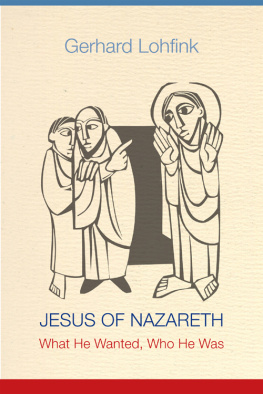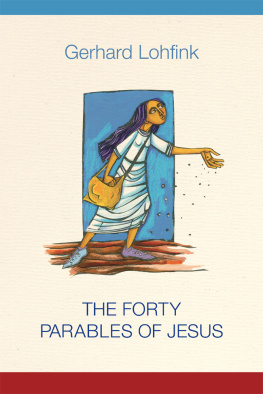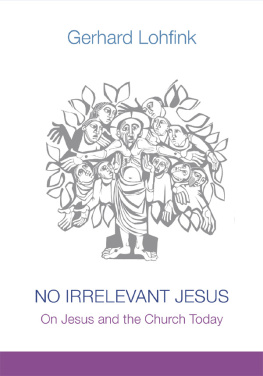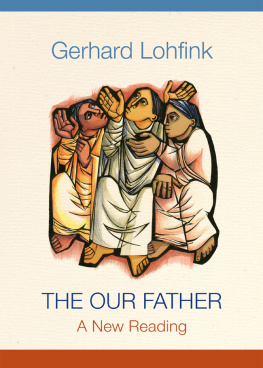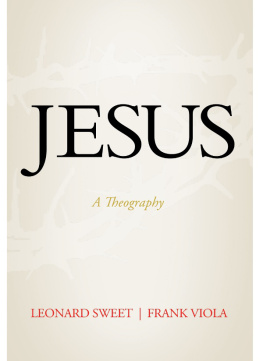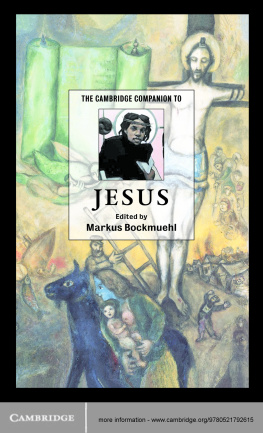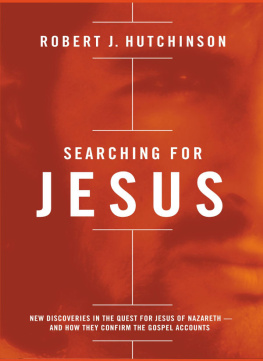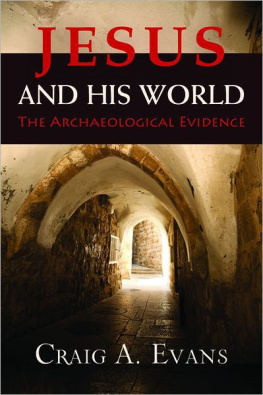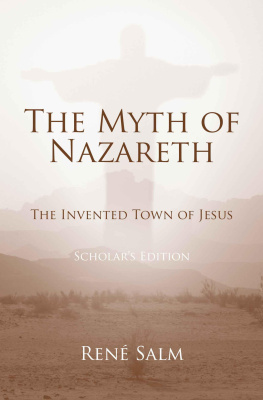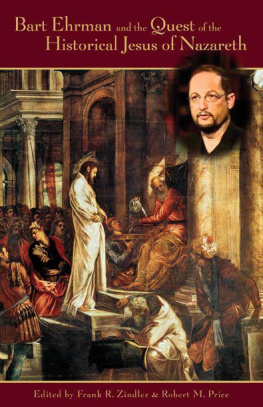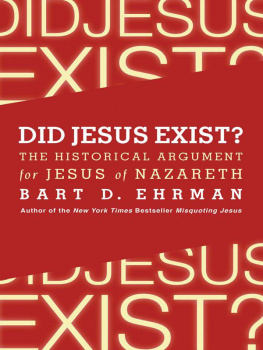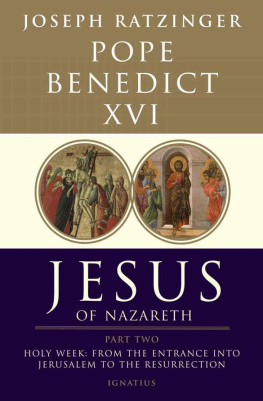Jesus of Nazareth
Gerhard Lohfink
Jesus of Nazareth
What He Wanted,
Who He Was
Translated by
Linda M. Maloney

LITURGICAL PRESS
Collegeville, Minnesota
www.litpress.org
A Michael Glazier Book published by Liturgical Press
Cover design by Ann Blattner. Illustrations by Br. Martin Erspamer, OSB, a monk of Saint Meinrad Archabbey, Indiana. Used with permission.
Scripture texts in this work are based on the New Revised Standard Version Bible 1989, Division of Christian Education of the National Council of the Churches of Christ in the United States of America. Used by permission. All rights reserved.
This volume was originally published in German as Jesus von Nazaret. Was er wollte, wer er war (Freiburg i.B.: Herder, 2011).
2012 by Order of Saint Benedict, Collegeville, Minnesota. All rights reserved. No part of this book may be reproduced in any form, by print, microfilm, microfiche, mechanical recording, photocopying, translation, or by any other means, known or yet unknown, for any purpose except brief quotations in reviews, without the previous written permission of Liturgical Press, Saint Johns Abbey, PO Box 7500, Collegeville, Minnesota 56321-7500. Printed in the United States of America.

Library of Congress Cataloging-in-Publication Data
Lohfink, Gerhard, 1934
[Jesus von Nazaret. English]
Jesus of Nazareth : what He wanted, who He was / Gerhard Lohfink; translated by Linda M. Maloney.
p. cm.
A Michael Glazier book.
Includes bibliographical references.
ISBN 978-0-8146-8058-2 ISBN 978-0-8146-8059-9 (ebook)
1. Jesus ChristHistoricity. 2. Jesus ChristPerson and offices.
I. Maloney, Linda M. II. Title.
BT303.2.L6413 2012
232dc23
2012020860
To the memory of
Father Heinrich Bacht, SJ

ponder daily over death and life,
if thou mightest find it,
and let thy bearing be joyous
and go not out of the world
without first having publicly testified
thy love and reverence
for the Author of Christianity.
Matthias Claudius, Letter To my son Johannes, 1799
Preface
There are innumerable books about Jesus. The reason is obvious: we can never finish with him, and every age must encounter him anew. Some of the many Jesus books are very good. Some are very bad. The bad ones are bad because they are far from understanding that the real historical Jesus cannot be grasped independently of faith in him. Which faith? That of the first witnesses and those who handed on the story, those who had to describe accurately or, better, faithfully to the person what had encountered them in Jesus.
Historical criticism is indispensable to research on Jesus. It illuminates the world in which Jesus lived, and still more, it works out the relationships among the sources of the gospels, illuminates the various layers of tradition, and thus sharpens our perception of what the evangelists wanted to say about Jesus in their final text. Historical criticism inquires persistently about what happened, and thus it demonstrates that Christianity is about real history and not about myths or ideologies. But when biblical critics measure Jesus only by their own prior understanding, deciding ahead of time what is historically possible and what is historically impossible, they exceed their own limitations.
Nowadays Jesus is far too often made to be merely a prophet, a gifted charismatic, a radical social revolutionary, a successful healer, a benevolent social worker, or even only a pious rabbi. The real claim of what is shown and expressed in Jesus is set aside, and the inevitable consequence is the assertion that the early Christian communities deified him.
The present book refuses to join in such reductionism, which goes contrary to the perceptions of the first witnesses and those who handed on the tradition. Its method is altogether historical and criticalhistorical research must always be criticalbut at the same time it agrees with Karl Barths statement in his commentary on Romans: For me, historical criticism has to be more critical!
This book intends to be serious about the fact that Jesus was a Jew and lived entirely in and out of Israels faith experiences, but at the same time he brought those experiences to their goal and fulfillment. Those who want to really understand Jesus and what he was cannot avoid allowing themselves to be drawn into this faith.
I desire nothing more than that this book will help many people today to approach the real Jesus by making critical distinctions and yet at the same time remaining open and full of trust.
Gerhard Lohfink
Bad Tlz
September 2011
Acknowledgments
This book is dedicated to the memory of Father Heinrich Bacht, SJ (19101986), in gratitude. He was professor of fundamental theology at the St. Georgen College of Philosophy and Theology in Frankfurt, and it was he who showed me the path to priesthood.
As I was writing this book there were four books on my desk that I repeatedly consulted: Peter Stuhlmacher, Biblische Theologie des Neuen Testaments , vol. 1 (Gttingen: Vandenhoeck & Ruprecht, 1992), and Martin Hengel and Anna Maria Schwemer, Jesus und das Judentum (Tbingen: Mohr Siebeck, 2007), as well as the two-volume book on Jesus by Pope Benedict XVI. Those four books were both an aid and a great joy to me.
My own book would not have come into being without the urging of my student and friend, Professor Dr. Marius Reiser. I thank him for many suggestions. Originally we intended a common project, but it may be as well that two different books came of it. They shed light on the same subject from different points of view. Marius Reisers book is titled Der unbequeme Jesus [ The Inconvenient Jesus ] and was published by the Neukirchener Verlag in 2011.
Heartfelt thanks for the English-language edition are due to my former doctoral student, the Rev. Dr. Linda Maloney. She contributed all her biblical scholarship skills and personal application to the translation. Without her and Mr. Hans Christoffersen, academic publisher of Liturgical Press, this English edition would never have seen the light of day.
I owe special thanks to my brother Norbert, professor emeritus of Old Testament at St. Georgen. He accompanied this book with his advice from the outset and constantly encouraged me. He continues to make Psalm 133 a reality.
Finally, my gratitude goes to Hans Pachner, faithful in fetching books for me, and to Hans Braun, my careful copyreader, as well as to my patient housemates Barbara Stadler and Manfred Lazarand with these four also the great crowd of companions on the way in the Katholische Integrierte Gemeinde. I do not know how I could live without their friendship and their faith.
Gerhard Lohfink
Abbreviations
ACW | Ancient Christian Writers |
ADPV | Abhandlungen des Deutschen Palstina-Vereins |
AnBib | Analecta biblica |
Ant. | Flavius Josephus, Antiquities of the Jews |
ANTZ | Arbeiten zur neutestamentlichen Theologie und Zeitgeschichte |
BDAG | Bauer, W., F. W. Danker, W. F. Arndt, and F. W. Gingrich. Greek-English Lexicon of the New Testament and Other Early Christian Literature. 3rd ed. Chicago, 1999. |

